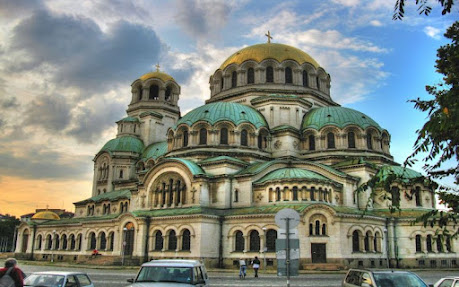"... Sofia tends to charm its visitors into lingering here indefinitely."
--Stephanie Craig=====================================================================
(near the geographical center of the Balkans region) The city of Sofia, famous for being one of Europe's oldest capitals, reflects the influence of other cthat of ultures like the Greeks, Arabs, Jews, and others. The city's most popular attractions are its massive houses of worship. (Visitors tend to love these places because they exude a peaceful atmosphere.) Found in the Sofia Valley at the foot of the Vitosha mountain, Bulgaria's capital is west of the Iskar river and has many mineral springs, such as the Sofia Central Mineral Baths.
+ Known as Serdica in antiquity and Sredets in the Middle Ages, Sofia has been an area of human habitation since at least 7000 BCE. The recorded history of the city begins with the conquest of Serdica by the Roman Republic in 29 BCE from the Celtic tribe Serdi. During the decline of the Roman Empire, the city was raided by Huns, Visigoths, Avars and Slavs. In 809, Serdica was incorporated into the Bulgarian Empire by Khan Krum and became known as Sredets. In 1018, the Byzantines ended Bulgarian rule until 1194, when it was reincorporated by the reborn Bulgarian Empire. Sredets soon became the cultural, administrative, economic, and literary hub (i.e., until its conquest by the Ottomans in 1382.) From 1530 to 1836, Sofia was the regional capital of Rumelia Eyalet, the Ottoman Empire's key province in Europe. (Bulgarian rule was restored in 1878. (Sofia became the capital of the Third Bulgarian State in 1879.). Vast parks and manicured gardens now offer the ski slopes and hiking trails of mighty Mt Vitosha are but a short bus ride from the city's center. Home to many of Bulgaria's finest museums, galleries, restaurants and clubs, Sofia may persuade you to linger longer too (to learn much more about this place.) During the 6th century Byzantine influence increased, which later gave the town its name,
+ Liberated from Byzantine rule from in1878, Sofia nd was designated the Bulgarian capital in April 3, 1879. Since the end of WWII, a agricultural zone characterized by fruit and vegetable growing (and by dairy farming) now surrounds Sofia.
+ Among the many educational institutions in Sofia are the Bulgarian Academy of Sciences, the Academy of Agricultural Sciences, and the University of Sofia (the oldest establishment of higher learning in Bulgaria). The city also contains the Cyril and Methodius National Library, the Ivan Vazov National Theater and Opera House, an astronomical observatory, and several museums. In addition to the restored St. George, Boyana, and St. Sofia churches, historical monuments include two mosques, one housing a fine archaeological collection, and the St. Alexander Nevsky Cathedral, erected to commemorate the gratitude of the Bulgarian people to the Russian liberators of 1878.
+ Shown here is Sofia's St. Alexander Nevski Cathedral, the oldest church in the Bulgarian capital:





No comments:
Post a Comment